|
|

Product Numbers: ACS-uBR7200-RMK=, uBR7246, ACS-uBR7223-RMK=, uBR7223
This document explains how to install the Cisco uBR7200 series universal broadband routers (which consist of the Cisco uBR7246 and the Cisco uBR7223) in an equipment rack and how to install the cable-management bracket on a Cisco uBR7200 series router using the rack-mount and cable-management kit. The kit includes rack-mount brackets and a cable-management bracket.
The rack-mount brackets are designed for mounting a Cisco uBR7200 series router in 19-in., 4-post and telco-type equipment racks. The cable-management bracket is designed to relieve strain on interface cables that are connected to port adapters and cable modem cards installed in a Cisco uBR7200 series router.
The cable-management bracket can be installed on a Cisco uBR7200 series router that is installed on a tabletop or workbench, or in a rack. The rack-mount and cable-management brackets are shipped with the Cisco uBR7200 series and are also available as a single field-replaceable unit (FRU).
This document includes the following sections:
The Cisco IOS software running on your router contains extensive features and functionality. The effective use of many of these features is easier if you have more information at hand. For additional information on configuring and maintaining a Cisco uBR7200 series router, the following documentation resources are available:
This section provides a list of parts and tools you need to install the rack-mount and cable-management brackets on a Cisco uBR7200 series router. This section also includes safety and ESD-prevention guidelines to help you avoid injury to yourself and damage to the equipment.
You will need the following parts and tools to install the rack-mount and cable-management brackets on your Cisco uBR7200 series. If you need additional equipment, contact a service representative for ordering information.
The rack-mount and cable-management kit includes the following parts:
Following are safety guidelines that you should follow when working with any equipment that connects to electrical power or telephone wiring.
 | Warning This warning symbol means danger. You are in a situation that could cause bodily injury. Before you work on any equipment, be aware of the hazards involved with electrical circuitry and be familiar with standard practices for preventing accidents. To see translations of the warnings that appear in this publication, refer to the Regulatory Compliance and Safety Information document that accompanied this device. |
Waarschuwing Dit waarschuwingssymbool betekent gevaar. U verkeert in een situatie die lichamelijk letsel kan veroorzaken. Voordat u aan enige apparatuur gaat werken, dient u zich bewust te zijn van de bij elektrische schakelingen betrokken risico's en dient u op de hoogte te zijn van standaard maatregelen om ongelukken te voorkomen. Voor vertalingen van de waarschuwingen die in deze publicatie verschijnen, kunt u het document Regulatory Compliance and Safety Information (Informatie over naleving van veiligheids- en andere voorschriften) raadplegen dat bij dit toestel is ingesloten.
Varoitus Tämä varoitusmerkki merkitsee vaaraa. Olet tilanteessa, joka voi johtaa ruumiinvammaan. Ennen kuin työskentelet minkään laitteiston parissa, ota selvää sähkökytkentöihin liittyvistä vaaroista ja tavanomaisista onnettomuuksien ehkäisykeinoista. Tässä julkaisussa esiintyvien varoitusten käännökset löydät laitteen mukana olevasta Regulatory Compliance and Safety Information -kirjasesta (määräysten noudattaminen ja tietoa turvallisuudesta).
Attention Ce symbole d'avertissement indique un danger. Vous vous trouvez dans une situation pouvant causer des blessures ou des dommages corporels. Avant de travailler sur un équipement, soyez conscient des dangers posés par les circuits électriques et familiarisez-vous avec les procédures couramment utilisées pour éviter les accidents. Pour prendre connaissance des traductions d'avertissements figurant dans cette publication, consultez le document Regulatory Compliance and Safety Information (Conformité aux règlements et consignes de sécurité) qui accompagne cet appareil.
Warnung Dieses Warnsymbol bedeutet Gefahr. Sie befinden sich in einer Situation, die zu einer Körperverletzung führen könnte. Bevor Sie mit der Arbeit an irgendeinem Gerät beginnen, seien Sie sich der mit elektrischen Stromkreisen verbundenen Gefahren und der Standardpraktiken zur Vermeidung von Unfällen bewußt. Übersetzungen der in dieser Veröffentlichung enthaltenen Warnhinweise finden Sie im Dokument Regulatory Compliance and Safety Information (Informationen zu behördlichen Vorschriften und Sicherheit), das zusammen mit diesem Gerät geliefert wurde.
Avvertenza Questo simbolo di avvertenza indica un pericolo. La situazione potrebbe causare infortuni alle persone. Prima di lavorare su qualsiasi apparecchiatura, occorre conoscere i pericoli relativi ai circuiti elettrici ed essere al corrente delle pratiche standard per la prevenzione di incidenti. La traduzione delle avvertenze riportate in questa pubblicazione si trova nel documento Regulatory Compliance and Safety Information (Conformità alle norme e informazioni sulla sicurezza) che accompagna questo dispositivo.
Advarsel Dette varselsymbolet betyr fare. Du befinner deg i en situasjon som kan føre til personskade. Før du utfører arbeid på utstyr, må du vare oppmerksom på de faremomentene som elektriske kretser innebærer, samt gjøre deg kjent med vanlig praksis når det gjelder å unngå ulykker. Hvis du vil se oversettelser av de advarslene som finnes i denne publikasjonen, kan du se i dokumentet Regulatory Compliance and Safety Information (Overholdelse av forskrifter og sikkerhetsinformasjon) som ble levert med denne enheten.
Aviso Este símbolo de aviso indica perigo. Encontra-se numa situação que lhe poderá causar danos físicos. Antes de começar a trabalhar com qualquer equipamento, familiarize-se com os perigos relacionados com circuitos eléctricos, e com quaisquer práticas comuns que possam prevenir possíveis acidentes. Para ver as traduções dos avisos que constam desta publicação, consulte o documento Regulatory Compliance and Safety Information (Informação de Segurança e Disposições Reguladoras) que acompanha este dispositivo.
¡Advertencia! Este símbolo de aviso significa peligro. Existe riesgo para su integridad física.
Antes de manipular cualquier equipo, considerar los riesgos que entraña la corriente eléctrica y familiarizarse con los procedimientos estándar de prevención de accidentes. Para ver una traducción de las advertencias que aparecen en esta publicación, consultar el documento titulado Regulatory Compliance and Safety Information (Información sobre seguridad y conformidad con las disposiciones reglamentarias) que se acompaña con este dispositivo.
Varning! Denna varningssymbol signalerar fara. Du befinner dig i en situation som kan leda till personskada. Innan du utför arbete på någon utrustning måste du vara medveten om farorna med elkretsar och känna till vanligt förfarande för att förebygga skador. Se förklaringar av de varningar som förkommer i denna publikation i dokumentet Regulatory Compliance and Safety Information (Efterrättelse av föreskrifter och säkerhetsinformation), vilket medföljer denna anordning.
Follow these basic guidelines when working with any electrical equipment:
A fully configured Cisco uBR7246 weighs approximately 100 lb (45.4 kg). A fully configured Cisco uBR7223 weighs approximately 75 lb (34.0 kg). The chassis is not intended to be moved frequently. Before you install the router, ensure that your site is properly prepared, so you can avoid having to move the chassis later to accommodate power sources and network connections.
Whenever you lift the chassis or any heavy object, follow these guidelines (see Figure 1):
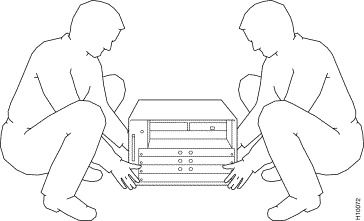
The rack-mounting hardware included with your Cisco uBR7200 series is suitable for most 19-in., 4-post and telco-type equipment racks. Some equipment racks provide a power strip along the length of one of the mounting strips. Figure 2 shows a typical 19-in., 4-post equipment rack with a power strip along one of the back posts.
If your rack has a power strip, consider the position of the strip when planning fastener points to ensure that you will be able to pull port adapters and other FRUs straight out of their respective slots. If the power strip does impair a rear rack-mount installation, remove the power strip before installing the router in the rack, then replace it after the chassis is installed.

To use the rack-mounting hardware provided with your Cisco uBR7200 series, consider the following guidelines:
When planning your rack installation, consider the following guidelines:
 | Caution To prevent chassis overheating, never install your Cisco uBR7200 series in an enclosed rack or room that is not properly ventilated or air conditioned. |
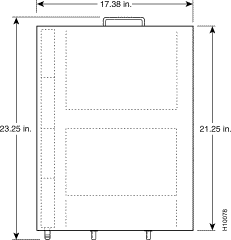
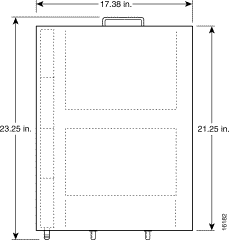
 | Warning To prevent injury, review the safety precautions in the section "Safety Guidelines" before installing the router in a rack. |
The chassis mounts to two rack posts with two brackets that attach to either the front, middle, or rear sides of the chassis. To install the rack-mount brackets at the rear of the chassis in a 4-post rack installation, see Figure 5. To install the rack-mount brackets at the front of the chassis with the chassis mounted flush with the front rack in a 4-post rack installation, see Figure 6. To install the rack-mount brackets at the front of the chassis and mounted with the chassis protruding from the rack in a 4-post rack installation, see Figure 7. To install the chassis in a telco-type rack, see Figure 8. To install the chassis in a 4-post rack with a cable management bracket, see Figure 9. To install the chassis in a telco-type rack with a cable management bracket, see Figure 10.
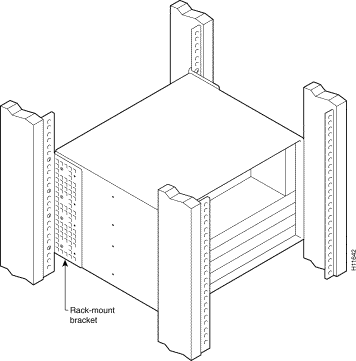

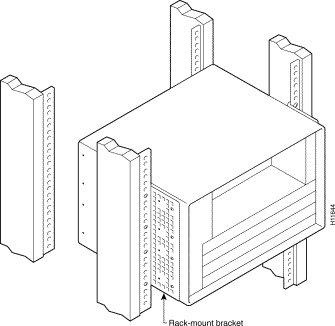
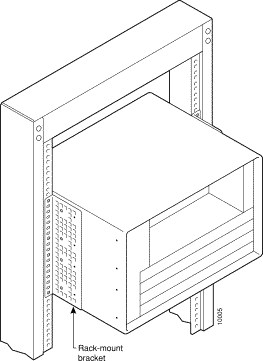
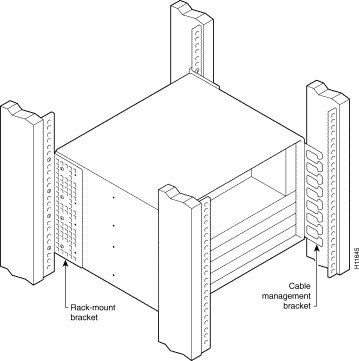
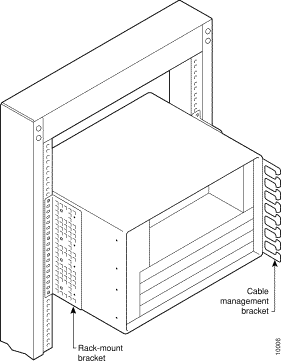
If you are rack-mounting a Cisco uBR7200 series from the rear, the rack-mount brackets are installed at the rear of the chassis, and the cable-management bracket is installed at the front of the chassis, on the right side. You must install both rack-mount brackets and the cable-management bracket before you install the chassis in the rack.
The following sections explain the procedure for rack-mounting the Cisco uBR7200 series:
These tasks are described in detail in the following subsections.
If your Cisco uBR7200 series is already installed on a tabletop or on a workbench, or in a rack, you must power down the router and disconnect input power before attempting the rack-mount procedure.
Step 1 Facing the rear of the router, place the power switch (on the power supply) in the OFF (0) position. Repeat this action if a second power supply is installed in the router.
Step 2 Observe the following items:
This completes the procedure for powering down the router. If you have an AC-input power supply installed in your Cisco uBR7200 series, proceed to the next section, "Disconnecting AC-Input Power." Otherwise, skip to the "Disconnecting DC-Input Power" section.
 | Caution When the input power to a Cisco uBR7246 power supply is disconnected or lost, the power supply will enter a reset cycle for 90 seconds. Wait at least 90 seconds or move the power switch from one position to the other to restart the power supply. For example, if the power supply was ON when the power was disconnected or lost, move the power switch to the OFF position, then back to the ON position. If you do not wait the full 90 seconds or move the power switch from one position to the other, the power supply will not restart. |
The faceplate of the 550W AC-input power supply has a green OK LED, a power switch, a handle for removing, installing, and handling the power supply, an AC-input power receptacle, and two captive installation screws. (See Figure 11.)
Step 1 Unplug the AC-input power cable from the power source.
Step 2 Push the cable-retention clip that secures the input power cable to the router's power supply to the left.
Step 3 Unplug the other end of the input power cable from the power supply. (See Figure 11.)
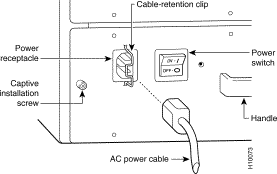
Step 4 Repeat Step 1 through Step 3 if a second power supply is installed.
This completes the procedure for disconnecting AC-input power. Skip to the "Installing the Brackets on the Chassis" section.
 | Warning Before completing any of the following steps, and to prevent short-circuit or shock hazards, ensure that power is removed from the DC circuit. To ensure that all power is OFF, locate the circuit breaker on the panel board that services the DC circuit, switch the circuit breaker to the OFF position, and tape the switch handle of the circuit breaker in the OFF position. |
 | Warning When installing the unit, the ground connection must always be made first and disconnected last. |
The faceplate of the 550W DC-input power supply has a green OK LED, a power switch, a handle for removing, installing, and handling the power supply, two DC-input power receptacles, two M5 grounding receptacles, a strain-relief cover that attaches to two M4 studs to secure the DC-input power leads, and two captive installation screws. (See Figure 13.)
Step 1 Ensure that the -48V and +48V leads are disconnected from the power source.
Step 2 Using a 7 mm wrench or nut driver (or adjustable wrench), loosen and remove the two M4 nuts from the strain-relief cover that secures the -48V and +48V leads to the power supply faceplate. (See Figure 12.)
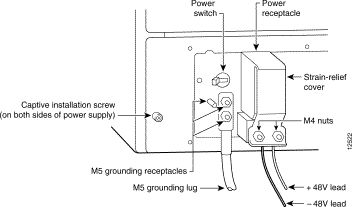
Step 3 Using a 3/16-in. flat-blade screwdriver, loosen the screw below the +48V lead receptacle and pull the lead from the connector. (See Figure 13.) Repeat this step for the -48V lead.
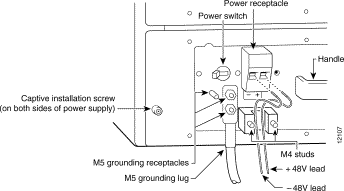
Step 4 Using an 8 mm wrench or nut driver (or adjustable wrench), loosen and remove the two M5 nuts that secure the two-hole-grounding lug to the grounding receptacle, and pull the grounding lug and lead from the receptacle. (See Figure 13.)
This completes the procedure for disconnecting DC-input power. Proceed to the following section "Installing the Brackets on the Chassis."
This section explains how to install the rack-mount brackets and cable-management bracket on a Cisco uBR7200 series router. Before installing the chassis in the rack, you must install a rack-mount bracket on each side of the front, middle, or rear of the chassis.
If you are rack-mounting the chassis from the front, you cannot use the cable-management bracket. If you are rack-mounting the chassis from the rear or middle of the chassis, you can install the rack-mount brackets and cable-management bracket separately; however, both rack-mount brackets and the single cable-management bracket must be installed on the chassis before the chassis is installed in the rack.
The parts and tools required for installing the rack-mount and cable-management brackets are listed in the "Parts and Tools" section of this document.
 | Warning After attaching the brackets, and to avoid injury, we recommend that two people install the chassis in the rack. (One person should support the chassis in the rack while the second person installs the fasteners.) |
Step 1 Locate the threaded holes in the front sides of the chassis.
Step 2 If you want the front of the chassis flush with the front of the rack, align the first rack-mount bracket to the threaded holes in the right side of the chassis as shown in Figure 14.
If you want the front of the chassis protruding from the rack, align the first rack-mount bracket to the threaded holes in the right side of the chassis as shown in Figure 15.
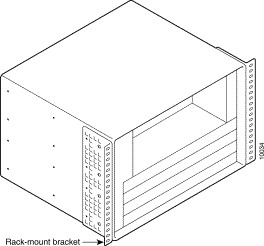

Step 3 If you aligned the first rack-mount bracket to the right side of the chassis, thread the M4 x 6-mm Phillips flathead screws (four for the Cisco uBR7246 and two for the Cisco uBR7223) through the bracket and into the side of the chassis. Use a no. 2 Phillips screwdriver to tighten the screws. (See Figure 14.)
Step 4 Repeat Step 1 through Step 3 for the other rack-mount bracket.
This completes the procedure for installing the rack-mount brackets on the chassis for a front rack-mount configuration. Proceed to the "Installing the Chassis in the Rack" section.
Step 1 Locate the threaded holes in the rear sides of the chassis.
Step 2 Align the first rack-mount bracket to the threaded holes in the right side of the chassis, and then align the rack-mount bracket to the chassis as shown in Figure 16.
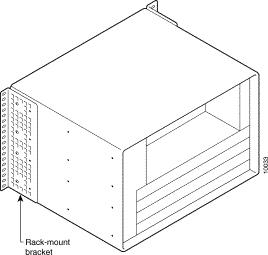
Step 3 Thread the M4 x 6-mm Phillips flathead screws (four for the Cisco uBR7246; two for the Cisco uBR7223) through the rack-mount bracket and into the side of the chassis. Use a no. 2 Phillips screwdriver to tighten the screws.
Step 4 Repeat Step 1 through Step 3 for the other rack-mount bracket.
Step 5 Thread the M4 x 6-mm Phillips panhead screws (four for the Cisco uBR7246; two for the Cisco uBR7223) through the cable-management bracket and into the chassis, and tighten the screws.
This completes the procedure for installing the rack-mount brackets and the cable-management bracket on the chassis for a rear rack-mount configuration. Proceed to the "Installing the Chassis in the Rack" section.
Step 1 Locate the threaded holes in the middle sides of the chassis.
Step 2 Align the first rack-mount bracket to the threaded holes in the right side of the chassis, and then align the rack-mount bracket to the chassis as shown in Figure 17.
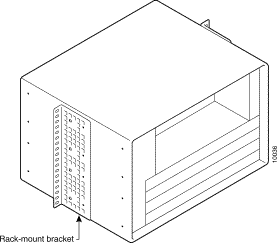
Step 3 Thread the M4 x 6-mm Phillips flathead screws (four for the Cisco uBR7246; two for the Cisco uBR7223) through the rack-mount bracket and into the side of the chassis. Use a no. 2 Phillips screwdriver to tighten the screws.
Step 4 Repeat Step 1 through Step 3 for the other rack-mount bracket.
Step 5 If you plan to include the cable-management bracket in your telco-type rack-mount configuration, align the bracket to the four right front side holes.
Step 6 If applicable, thread the M4 x 6-mm Phillips panhead screws (four for the Cisco uBR7246; two for the Cisco uBR7223) through the cable-management bracket and into the chassis, and tighten the screws.
 | Warning To prevent injury, review the safety precautions in the section "Safety Guidelines" before installing the router in a rack. |
This completes the procedure for installing the rack-mount brackets and the cable-management bracket on the chassis for a middle rack-mount configuration. Proceed to the new section "Installing the Chassis in the Rack."
After installing the brackets on the chassis, you mount the router by securing the rack-mount brackets to two posts or mounting strips in the rack using the four slotted screws provided. Because the brackets support the weight of the entire chassis, be sure to use all four slotted screws to fasten the two rack-mount brackets to the rack posts. Figure 6, Figure 7, Figure 8, Figure 9, and Figure 10 show typical installations in a 19-in., 4-post rack and a telco-type equipment rack.
We recommend that you allow at least one or two inches of vertical clearance between the router and any equipment directly above and below it.
 | Warning To prevent the rack from tipping when installing the router in telco-type racks, ensure that the rack is bolted to the floor and, if necessary, anchored with appropriate fixtures. |
 | Warning To maintain a low center of gravity, ensure that heavier equipment is installed near the bottom of the rack. |
Step 1 On the chassis, ensure that all captive screws on the network processing engine, the I/O controller, each cable modem card, and each power supply are tightened and the port adapter retention clips are in the locked position.
Step 2 Make sure that your path to the rack is unobstructed. If the rack is on wheels, ensure that the brakes are engaged or that the rack is otherwise stabilized.
 | Warning To prevent damage to the chassis or personal injury, never attempt to lift or tilt a Cisco uBR7200 series using the port adapter handles or the I/O controller handle; they are not designed to support the weight of the router. Always have someone help you when installing your Cisco uBR7200 series. |
Step 3 Position the chassis so that the front end is closest to you; then lift the chassis and move it to the rack. To prevent injury, avoid sudden twists or moves.
Step 4 Slide the chassis into the rack, pushing it back until the brackets (installed at the front or rear of the chassis) meet the mounting strips or posts on both sides of the equipment rack.
Step 5 While keeping the brackets flush against the posts or mounting strips, position the router so that the holes in the brackets are aligned to those in the mounting strips.
Step 6 Insert all four 10-32 x 3/8-in. slotted screws (two on each side) through the brackets and into the mounting strips. (Use two of the bracket holes; one near the top of the bracket and one near the bottom of the bracket.) Using a 1/4-in., flat-blade screwdriver, tighten all the screws.
This completes the procedure for installing the chassis in the rack. If you have an AC-input power supply installed in your Cisco uBR7200 series, proceed to the "Reconnecting AC-Input Power" section. Otherwise, skip to the "Reconnecting DC-Input Power" section.
Step 1 At the rear of the router, check that the power switch on the power supply is in the OFF (0) position.
Step 2 Push the cable-retention clip to the left, away from the AC receptacle, and plug in the power cable.
Step 3 Secure the cable in the power supply AC receptacle by sliding the cable-retention clip to the right until it snaps around the connector. The cable-retention clip provides strain relief for the AC power cable. (See Figure 18.)

Step 4 Plug the AC power supply cable into the AC power source.
Step 5 Repeat Step 1 through Step 4 if a second power supply is installed.
 | Caution When the power switch on a Cisco uBR7200 series power supply is turned to either the ON or OFF position, the power supply will enter a reset cycle for 90 sec Wait at least 90 sec before turning the power switch from one position to the other. If you do not wait the full 90 sec, the power supply will not restart. |
This completes the steps for reconnecting AC-input power. Skip to the "Powering Up the Router" section.
 | Warning Before completing any of the following steps, and to prevent short-circuit or shock hazards, ensure that power is removed from the DC circuit. To ensure that all power is OFF, locate the circuit breaker on the panel board that services the DC circuit, switch the circuit breaker to the OFF position, and tape the switch handle of the circuit breaker in the OFF position. |
 | Warning When installing the unit, the ground connection must always be made first and disconnected last. |
Step 1 Ensure that the -48V and +48V leads are disconnected from the power source.
Step 2 At the rear of the router, check that the power switch on the power supply is in the OFF (0) position.
Step 3 Connect the two-hole grounding lug on the grounding lead to the M5 grounding receptacles with the M5 nuts. Tighten the nuts using an 8 mm wrench or nut driver (or adjustable wrench). (See Figure 20.)
Step 4 If necessary, use a wire stripper to strip approximately 0.55 in. (14 mm) from the -48V and +48V leads. (See Figure 19.)

Step 5 Insert the stripped end of the +48V lead all the way into the +48V lead receptacle and tighten the receptacle screw using the same 3/16-in. flat-blade screwdriver. Repeat this step for the -48V lead.
Step 6 After tightening the receptacle screws and nuts for the ground, +48V, and -48V DC-input leads, run the +48V and -48V leads between the two strain-relief studs on the power supply faceplate. (See Figure 20.)
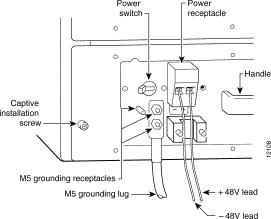
Step 7 Replace the strain-relief cover over the +48V and -48V leads and secure the cover to the strain-relief studs using the two M4 nuts with the 7 mm wrench or nut driver (or adjustable wrench). (See Figure 21.)
Step 8 Connect the ground, +48V, and -48V leads to the power source.
This completes the procedure for connecting DC-input power. Proceed to the following section "Powering Up the Router."
Step 1 Check for the following:
Step 2 At the rear of the router, place the power switch on the power supply in the ON (|) position. Repeat this step if a second power supply is installed in the router. The green OK LED on the power supply goes on.
Step 3 Listen for the fans; you should immediately hear them operating.
Step 4 During the boot process, observe the system's LEDs. The LEDs on most of the port adapters go on and off in irregular sequence. Some might go on, go out, and go on again for a short time. On the I/O controller, the IO Power OK LED goes on immediately.
Step 5 Observe the initialization process. When the system boot is complete (a few seconds), the network processing engine begins to initialize the port adapters and the I/O controller. During this initialization, the LEDs on each port adapter behave differently (most flash on and off). The enabled LED on each port adapter goes on when initialization is completed, and the console screen displays a script and system banner similar to the following:
Cisco Internetwork Operating System Software
IOS (tm) uBR7200 Software (uBR7200-I-M), Version 11.3(2)XA1 [smith 100]
Copyright (c) 1986-1998 by cisco Systems, Inc.
Compiled Sun 09-Mar-98 04:10 by smith
This completes the procedures for powering up the router. This also completes the procedures for rack-mounting Cisco uBR7200 series and attaching the cable-management bracket.
This section explains how to install the cable-management bracket on a Cisco uBR7200 series router in a tabletop or workbench installation. Instructions for installing the cable-management bracket on a Cisco uBR7200 series in a rack-mount installation are in the "Rack-Mounting the Cisco uBR7200 Series" section of this document. The list of tools and parts required to install the cable-management bracket are listed in the "Parts and Tools" section of this document.
Step 1 Ensure that input power to the router is turned off and disconnected. Refer to the "Powering Down the Router" section of this document for instructions.
Step 2 Locate the threaded holes in the right, front side of the chassis.
Step 3 Align the cable-management bracket to the threaded holes in the right side of the chassis at the front. (See Figure 16.)
Step 4 Thread the M4 x 6-mm Phillips panhead screws (four for the Cisco uBR7246; two for the Cisco uBR7223) through the bracket and into the chassis. Use a no. 2 Phillips screwdriver to tighten the screws.
This completes the steps for installing the cable-management bracket on a Cisco uBR7200 series in a workbench or tabletop configuration.
Cisco Connection Online (CCO) is Cisco Systems' primary, real-time support channel. Maintenance customers and partners can self-register on CCO to obtain additional information and services.
Available 24 hours a day, 7 days a week, CCO provides a wealth of standard and value-added services to Cisco's customers and business partners. CCO services include product information, product documentation, software updates, release notes, technical tips, the Bug Navigator, configuration notes, brochures, descriptions of service offerings, and download access to public and authorized files.
CCO serves a wide variety of users through two interfaces that are updated and enhanced simultaneously: a character-based version and a multimedia version that resides on the World Wide Web (WWW). The character-based CCO supports Zmodem, Kermit, Xmodem, FTP, and Internet e-mail, and it is excellent for quick access to information over lower bandwidths. The WWW version of CCO provides richly formatted documents with photographs, figures, graphics, and video, as well as hyperlinks to related information.
You can access CCO in the following ways:
For a copy of CCO's Frequently Asked Questions (FAQ), contact cco-help@cisco.com. For additional information, contact cco-team@cisco.com.

![]()
![]()
![]()
![]()
![]()
![]()
![]()
![]()
Posted: Wed Mar 24 17:20:58 PST 1999
Copyright 1989-1999©Cisco Systems Inc.